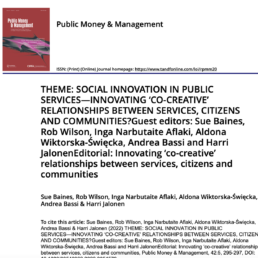The authors report and analyse innovative co-creative initiatives involving marginalized and stigmatized groups (prisoners, urban racialized minorities, rural poor populations including Roma).
Authors
Sue Baines, Rob Wilson, Inga Narbutaite Aflaki, Aldona Wiktorska-Święcka, Andrea Bassi and Harri Jalonen
Abstract
Public services face growing pressure to innovate but there is little agreement how this can be achieved (Hartley, 2014). Social innovation is explicitly about addressing human needs and its place in public policy is well established (Marques et al., 2017; Sabato et al., 2017). This Public Money & Management (PMM) theme puts a spotlight on the intersection of social innovation and co-creation. Co-creation is a more recent entrant to policy agenda than social innovation but also appears to have achieved the status of an orthodoxy (Osborne et al., 2016; Torfing et al., 2019). In the context of public services, co-creation is characterised as ‘active involvement of end-users in various stages of the production process’ (Voorberg et al., 2015, p. 1335). There are variations in detail and emphases vis-à-vis the longer established term ‘co-production’ (Brandsen & Honingh, 2018; Bovaird et al., 2019). A common thread in co-creation is that people typically called ‘service users’ or ‘beneficiaries’ become seen as asset holders with legitimate knowledge about what their services should comprise (Fox et al., 2021; Wiktorska-Święcka, 2021).
Publication link
Full reference
Baines, S., Wilson, R., Aflaki, I. N., Wiktorska-Święcka, A., Bassi, A., and Jalonen, H. (2022) Editorial: Innovating ‘co-creative’ relationships between services, citizens and communities. Public Money and Management, 42(5) pp. 295-297.
Linked Project
